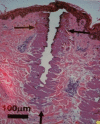Update of Ablative Fractionated Lasers to Enhance Cutaneous Topical Drug Delivery
- PMID: 28687935
- PMCID: PMC5565660
- DOI: 10.1007/s12325-017-0516-9
Update of Ablative Fractionated Lasers to Enhance Cutaneous Topical Drug Delivery
Abstract
Ablative fractional lasers (AFXL) enhance uptake of therapeutics and this newly emerging field is called laser-assisted drug delivery (LAD). This new science has emerged over the past decade and is finding its way into clinical practice. LAD is poised to change how medicine delivers drugs. Topical and systemic application of pharmaceutical agents for therapeutic effect is an integral part of medicine. With topical therapy, the stratum corneum barrier of the skin impairs the ability of drugs to enter the body. The purpose of LAD is to alter the stratum corneum, epidermis, and dermis to facilitate increased penetration of a drug, device, or cell to its respected target. AFXL represents an innovative, non-invasive strategy to overcome the epidermal barrier. LAD employs three steps: (1) breakdown of the skin barrier with a laser, (2) optional use a laser for a therapeutic effect, (3) delivery of the medicine through laser channels to further enhance the therapeutic effect. The advantages of using lasers for drug delivery include the ease of accessibility, the non-invasive aspect, and its effectiveness. By changing the laser settings, one may use LAD to have a drug remain locally within the skin or to have systemic delivery. Many drugs are not intended for use in the dermis and so it has yet to be determined which drugs are appropriate for this technique. It appears this developing technology has the ability to be a new delivery system for both localized and systemic delivery of drugs, cells, and other molecules. With responsible development AFXL-assisted drug delivery may become a new important part of medicine.
Keywords: Delivery; Drug; Energy device; Laser; Systematic.
Figures



Similar articles
-
Laser-assisted delivery of topical methotrexate - in vitro investigations.Dan Med J. 2016 Jun;63(6):B5254. Dan Med J. 2016. PMID: 27264947 Review.
-
Translational medicine in the field of ablative fractional laser (AFXL)-assisted drug delivery: A critical review from basics to current clinical status.J Am Acad Dermatol. 2016 May;74(5):981-1004. doi: 10.1016/j.jaad.2015.12.008. Epub 2016 Feb 28. J Am Acad Dermatol. 2016. PMID: 26936299 Review.
-
Fractional laser-assisted drug delivery: Laser channel depth influences biodistribution and skin deposition of methotrexate.Lasers Surg Med. 2016 Jul;48(5):519-29. doi: 10.1002/lsm.22484. Epub 2016 Feb 5. Lasers Surg Med. 2016. PMID: 26846733
-
Fractional laser-assisted topical delivery leads to enhanced, accelerated and deeper cutaneous 5-fluorouracil uptake.Expert Opin Drug Deliv. 2017 Mar;14(3):307-317. doi: 10.1080/17425247.2017.1260119. Epub 2016 Nov 28. Expert Opin Drug Deliv. 2017. PMID: 27835937
-
Fractional laser-assisted drug delivery: Active filling of laser channels with pressure and vacuum alteration.Lasers Surg Med. 2016 Feb;48(2):116-24. doi: 10.1002/lsm.22374. Epub 2015 Aug 17. Lasers Surg Med. 2016. PMID: 26280816
Cited by
-
Ex Vivo Human Histology Fractional Treatment with a New CO2 Scanner: A Potential Application on Deep Scarring.Medicina (Kaunas). 2023 Jun 9;59(6):1117. doi: 10.3390/medicina59061117. Medicina (Kaunas). 2023. PMID: 37374321 Free PMC article.
-
Application of microneedle patches for drug delivery; doorstep to novel therapies.J Tissue Eng. 2022 Apr 29;13:20417314221085390. doi: 10.1177/20417314221085390. eCollection 2022 Jan-Dec. J Tissue Eng. 2022. PMID: 35516591 Free PMC article. Review.
-
Beneath the Surface: A Review of Laser Remodeling of Hypertrophic Scars and Burns.Adv Wound Care (New Rochelle). 2019 Apr 1;8(4):168-176. doi: 10.1089/wound.2018.0857. Epub 2019 Apr 3. Adv Wound Care (New Rochelle). 2019. PMID: 31832273 Free PMC article. Review.
-
Fractional carbon dioxide laser alone and as an assisted drug delivery for treatment of alopecia areata: a clinical, dermoscopic and immunohistochemical study.Arch Dermatol Res. 2023 Aug;315(6):1675-1688. doi: 10.1007/s00403-023-02565-x. Epub 2023 Feb 21. Arch Dermatol Res. 2023. PMID: 36809409 Free PMC article.
-
Transdermal Delivery of Therapeutic Compounds With Nanotechnological Approaches in Psoriasis.Front Bioeng Biotechnol. 2022 Jan 24;9:804415. doi: 10.3389/fbioe.2021.804415. eCollection 2021. Front Bioeng Biotechnol. 2022. PMID: 35141215 Free PMC article. Review.
References
-
- Nino M, Calabro G, Santoianni P. Topical delivery of active principles: the field of dermatological research. Dermatol Online J. 2010;16(1):4. - PubMed
-
- Waibel JS, Rudnick A, Nousari C, Bhanusali DG. Fractional ablative laser followed by transdermal acoustic pressure wave device to enhance the drug delivery of aminolevulinic acid. In vivo fluorescence microscopy study. J Drugs Dermatol. 2016;15(1):14–21. - PubMed
-
- Sklar L, Burnett C, Waibel J, Moy R, Ozog D. Laser assisted drug delivery: a review of an evolving technology. Lasers Surg Med. 2014;9999:1–14. - PubMed
Publication types
MeSH terms
Substances
LinkOut - more resources
Full Text Sources
Other Literature Sources
Medical
Miscellaneous

